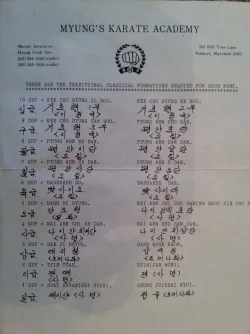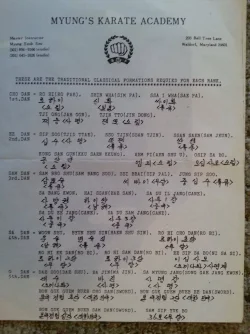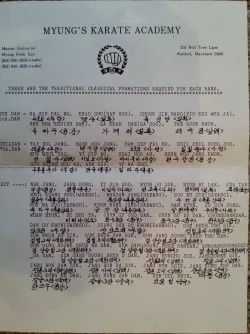reeskm
Green Belt
TSD Texan started a thread about our individual lineages to Hwang Kee, which was getting a bit off topic into the usual interest in Toyama Kanken and Shudokan.
So, I forked that thread and started a new one. I aim to discuss what I know with others regarding Manchuria and Hwang Kee's early life, including what I know about the period here.
This is what I was going to post in the lineage thread that is considerably off topic:
I have spoken to a student of Ki Whang Kim (KWK), who claimed that he did not teach full time in Korea when he returned there after WW2. Instead, he had a government position (office job) and would go to all the dojangs and train with others and teach others forms and techniques when he had the time. This student of KWK was of the opinion that he helped polish the forms in the early Moo Duk Kwan, but we should be careful about how we (as aspiring historians) take such a statement for granted.
My personal feeling is that people were relatively friendly and helpful in the begging, and freely and happily shared technique with each other. Everybody was eager to learn from anybody with experience. I don't like to just assume that this person or that person was the only person responsible for someone else's technique. That is not how we learn - we get a little from everybody - but for sure we can say that the inflence on early MDK wasn't only "Shotokan"!
As for Yamaguchi, this is very hard to say. He appeared together with Hwang at many FAJKO/AKF/WUKO (now WKF) events in the mid 60s to early 70s, but after that there is no evidence of how well they knew each other. I don't think a lot of people would disagree with me when I say that, other than philosophy, there is no goju technique in MDK, at least not now!
Besides, there were so many other people in Manchukuo with a Karate or MA background from 1920s-1945.
So, I forked that thread and started a new one. I aim to discuss what I know with others regarding Manchuria and Hwang Kee's early life, including what I know about the period here.
This is what I was going to post in the lineage thread that is considerably off topic:
I have spoken to a student of Ki Whang Kim (KWK), who claimed that he did not teach full time in Korea when he returned there after WW2. Instead, he had a government position (office job) and would go to all the dojangs and train with others and teach others forms and techniques when he had the time. This student of KWK was of the opinion that he helped polish the forms in the early Moo Duk Kwan, but we should be careful about how we (as aspiring historians) take such a statement for granted.
My personal feeling is that people were relatively friendly and helpful in the begging, and freely and happily shared technique with each other. Everybody was eager to learn from anybody with experience. I don't like to just assume that this person or that person was the only person responsible for someone else's technique. That is not how we learn - we get a little from everybody - but for sure we can say that the inflence on early MDK wasn't only "Shotokan"!
As for Yamaguchi, this is very hard to say. He appeared together with Hwang at many FAJKO/AKF/WUKO (now WKF) events in the mid 60s to early 70s, but after that there is no evidence of how well they knew each other. I don't think a lot of people would disagree with me when I say that, other than philosophy, there is no goju technique in MDK, at least not now!
Besides, there were so many other people in Manchukuo with a Karate or MA background from 1920s-1945.
- So Nei Chu (famously jailed for his leftist leanings)
- Mitsusuke Harada (just a boy at the time, mind you)
- Yamaguchi Gogen (Military Intelligence in Manchukuo, imprisoned by the Russians)
- The Koreans we know: Yun Byung-In, Yun Kwei-Byung, Chun Sang Sup, Hwang Kee
- Masayoshi Kori Hisataka (station master on the SMR!)
- Kinjo Hiroshi (I believe he worked with the SMR's railway police, but can't find it on the web again - search IRKRS websites for more)
- Isao Obata (See Nov 1992 Black Belt Mag for story - was army officer in Manchukuo)
- A university in Manchuria hosted many martial artists, including Ueshiba, and which taught colonial students in Aikido, Kendo and Judo. When the russians were on their doorstep, the University books and course materials were moved to south korea to a now prominent university in Seoul... (Read Wikipedia and put it together! It's hiding in plain sight.)
- Kotaro Yoshida lived in Manchuria on and off over the years.
- Gigo Funakoshi and Morihei Ueshiba trained special forces agents for missions into Manchuria at the Nakano-ryu (Nakano School)
- Takatoshi Nishizono (Wado) trained Sakura Squadrons in Manchukuo when he was stationed there, and wrote a famous essay about it.
- And then you have all the "others"... Manchukuo was running amok in "Tairiku Ronin" during this period. Not to mention many young men and karateka were sent here as part of their military duty. Dark times, a swirling dark pool of intrigue up to the Amur River. Black dragons lived here during this time... Some things will never be known about this period, and who was there!



